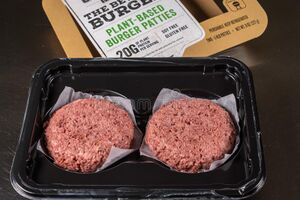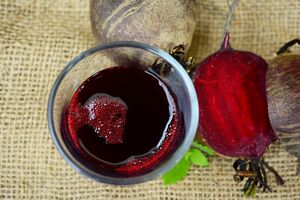Course:FNH200/Projects/2022/Beyond Meat Burger
Preliminary Questions and Outlines
This is a blank page for you to document and present your research project for FNH 200.
In addition to the traditional introduction, body of research, and references, don't forget to include a fact that you like your fellow students to know. Please present the fact in a format of Canvas quiz (multiple choice, multiple answers, fill in the blank, matching, etc), including the question, correct answers, distractors, as well as a quick explanation why your fellow students should know about this.
Your team reflection, one submission per team, should be submitted on Canvas.

- The food or the food-related issue you like to explore as a team:
- Beyond Meat Burger
- A list of possible subtopics (questions):
- Why is it packaged the way it is? Does this extend the shelf-life? Does it prevent microbial growth? Why must it be stored this way? And how does the shelf life different from its meat counterparts (ie. a beef burger)?
- How are beyond meat burgers made? (what is added to make plants taste like meat)
- How does the nutritional content of beyond meat compare to regular?
- Are beyond meat burgers a more sustainable choice, if everyone switched to beyond meat, how big of an impact would this make?
- What is the molecular/microbial/chemical explanation for its accurate meat-like aroma, appearance and texture?
- How are beyond meat burgers processed to make it look like real meat (ie. the raw look in the middle once they are cooked)?
- Are beyond meat burgers available everywhere? Any restrictions to shipping/importing/exporting to other countries? If there are regulations, what are the reasons behind the regulations?
- A list of your potential resources: websites, links, etc.
- https://www.beyondmeat.com/en-CA/products/beyond-beef.
- https://recalls-rappels.canada.ca/en/alert-recall/health-canada-reminds-canadians-important-summer-food-safety-tips.
- https://www.health.harvard.edu/blog/impossible-and-beyond-how-healthy-are-these-meatless-burgers-2019081517448.
- https://news.ubc.ca/2019/09/13/beyond-meat-elevates-veggie-burgers-taste-but-what-about-nutrition/.
- https://www.youtube.com/watch?v=KyfpipXpxLM.
- https://sciencemeetsfood.org/plant-based-burgers/#:~:text=Beyond%20Meat%20really%20does%20a,the%20texture%20of%20animal%20meat.&text=Aside%20from%20the%20texture%20component,the%20fats%20found%20in%20meat.
- https://sciencemeetsfood.org/plant-based-burgers/#:~:text=Beyond%20Meat%20really%20does%20a,the%20texture%20of%20animal%20meat.&text=Aside%20from%20the%20texture%20component,the%20fats%20found%20in%20meat.
- https://www.forbes.com/sites/katrinafox/2018/09/26/this-vegan-brand-just-proved-that-plant-based-burgers-are-more-sustainable-than-those-made-of-beef/#139afbd1475a.
- https://www.nbcnews.com/news/us-news/fake-meat-better-you-or-environment-n1065231.
- https://sustainablereview.com/is-beyond-meat-sustainable/.
- https://www.nytimes.com/2021/10/15/business/beyond-meat-impossible-emissions.html.
- https://www.leafscore.com/eco-friendly-kitchen-products/plant-based-meat-has-a-packaging-problem/.
- http://www.designlife-cycle.com/beyond-meat
Research Questions
Why is it packaged the way it is? Does this extend the shelf-life? Does it prevent microbial growth? Why must it be stored this way?
Eating plant-based has a positive impact on the environment by lessening our carbon footprint. Beyond meat, burgers have serious packaging issues in terms of sustainability but are still a more sustainable option than animal agriculture.
These plant-based burgers are packaged in a non-biodegradable polypropylene thermoformed tray and then surrounded by wax patty paper, plastic and cardboard.

Thermoformed plastic is heat resistant, allowing it to be molded into patty-sized circles; it is also low cost and durable, making it a standout choice for manufacturers. Polypropylene’s thermal conductivity is very low, allowing the beyond meat burger to be kept at a stable temperature regardless of the elements surrounding it. The durability of polypropylene ensures the burgers are protected from the outside physical force—both the thermal conductivity and durability of polypropylene cause the burgers to stay fresh longer. [1]The plastic wrap allows for product visibility by the consumers, which can influence their decision on purchasing the product. Encasing the product in cardboard provides protection from the elements, easy opening by the consumer, and customizable packaging. The manufacturer can be creative with the design as long as it meets packaging regulations. see here for labelling requirements. Beyond meat burgers are a perishable food product meaning that refrigeration is required to extend their shelf life. A refrigeration temperature of 4 degrees celsius or below is vital to suppress any growth of disease-causing microorganisms. If you notice that there seems to be extra air within the package/the plastic has puffed up, it is likely expired. This is because the microorganisms that cause food spoilage (bacteria, yeast, and molds) feed on the Beyond Meat burger and release gas as waste.[2]
How are Beyond Meat burgers made?
Beyond meat consists of Water, Pea protein, Canola oil, Refined coconut oil, Rice protein, Flavour, Cocoa butter, Dried yeast, Mung bean protein, Methylcellulose, Potato starch, Sugars (apple extract, pomegranate extract), Potassium chloride, Yeast extract, Beet juice extract (vegetable glycerin, water, maltodextrin, ascorbic acid), Salt, Sunflower Lecithin, Vinegar, Concentrated lemon juice, Carrot powder, Vitamins and minerals (niacin [vitamin B3], pyridoxine hydrochloride [vitamin B6], thiamine hydrochloride [vitamin B1], riboflavin [vitamin B2], folic acid [vitamin B9], cyanocobalamin [vitamin B12], calcium pantothenate, biotin, zinc sulphate, ferric orthophosphate).[3]
Beyond Meat Brand has not publicly stated specific details of the process they use to create their burgers, other than a brief summary of their production process on their website: Stating that they use “a simple process of heating, cooling, and pressure to create the fibrous texture of meat and layer in plant-based fats, binders, flavors, and colors.”[4]
The core of beyond meat is its pea protein, beyond meat has patented a process that alters the structure and presentation of pea protein for their product. The pea protein is first formed into a dough under alkaline conditions, then it is extruded to help denature and align the proteins in a fibrous, meat-like network, and then set into a fixed fibrous structure as it is cooled through a die. Thus, the vegetable protein undergoes great pressure and shear to form it into a texture similar to animal meat.[5]
The FDR's current guidelines[6] [7] for simulated meat and simulated poultry products apply to products that are made to resemble meat or poultry products. They state that simulated meat products such as beyond meat are required to:
- be clearly represented as simulated meat
- be clearly labelled as such
- meet specific requirements for composition and fortification
- must carry the declaration "contains no meat" on the label, next to the common name
- declare in absolute amounts and as a percent daily value per serving of stated size the vitamins and mineral nutrients added
And other general labelling requirements for meat and poultry products, such as a common name, list of ingredients, net quantity, country of origin, nutrition labelling, date markings and storage instruction, etc.
How are Beyond Meat burgers processed to resemble animal-based burgers in texture, appearance, and flavour so accurately? (ie. the raw look in the middle once they are cooked)?
The major overcoming factor that producers really needed to accomplish was the meaty texture that animal products naturally have. Animal meat proteins are fibrous and three-dimensional which allows it to have a firmness and cohesion of the food matrix. Within the matrix, water, carbohydrates, fats and flavors are enclosed and then shaped to be delivered to consumers in the desired form (sausage, patty, meatballs, etc). The ultimate goal for plant based protein companies was to mimic or even achieve the same protein matrix that allows us to enjoy foods like cheeseburgers.
Biochemistry researchers spent more than six years in the laboratory formulating the Beyond Meat burger patty. Ethan Brown and his professors at the University of Missouri worked together to utilize heating, cooling, pressure, and shearing treatments via a food extrusion machine to process a meat-like texture that resembles muscle fibres.[8]
The following ingredients are found in beyond meat burger patties: water, pea protein isolate, expeller-pressed canola oil, refined coconut oil, rice protein, natural flavors, cocoa butter, mung bean protein, methylcellulose, potato starch, apple extract, salt, potassium chloride, vinegar, lemon juice concentrate, sunflower lecithin, pomegranate fruit powder and beet juice extract.
The matrix is primarily formed from the pea protein isolate. Under alkaline conditions (high pH), the pea protein is formed into a malleable dough which is then extruded to denature the protein into the fibrous matrix after it has been set. The extrusion allows for the vegetables (pea) proteins to undergo immense pressure and shear it to form into a texture similar to animal meat. The fibrous texture is further derived from rice, mung bean, and faba bean. This complex plant protein variety also delivers a complete amino acid profile and grams of protein comparable to animal-based burgers.[9] Coconut oil and cocoa butter are strategically placed in the Beyond Meat patty to resemble fat marbling and replicate the cooking process (sizzling fat on the grill), in addition to contributing to a fatty flavour and texture profile for a melt-in-your-mouth feel.[10]
The Beyond Meat burger contains beet juice to replicate the way a real beef burger is red on the inside and bleeds upon eating-- a trademark of a high-quality beef burger. Betalain is a pigment found in beet juice that is stable at room temperature but unstable at high temperatures. As the Beyond Meat patty is being cooked, the betalain in the beet juice will brown as it degrades, further resembling the “medium rare” look when heat is applied to real animal meat.[11]
Potato starch is used to help bind/shape the patty by absorbing excess water. Vinegar and lemon are used for both flavour and coagulation of the proteins which ultimately aids in texture. Pomegranate fruit powder is used for flavour as it provides acidity and richness to the mixture. Methyl-cellulose is used as an emulsifier and thickener. Rice protein and mung bean protein are used as a protein component aiding in the formation of the meat matrix. The complex mixture and chemistry of these components allows consumers to enjoy a plant-based alternative to meat.
Exam Question
- What ingredient is used to simulate blood in the Beyond Meat burger? a) Pomegranate juice b) Fish blood d) Beet juice* e) Cow blood
- *Bolded answer is the correct answer.
- Although this was not specifically taught in FNH 200 we did learn about appearance factors in lesson 3. In this lesson we learned that appearance is a measure of food quality. The pink we see in a typical beef burger indicates that it is fresh and superior quality. Simulating this in Beyond meat burgers is important as consumers will likely be drawn to the pink colour as they are accustomed to looking for this in regular beef burgers. There are pigments in beets that give them their red colour, these are called betalains. This simulates the hemoglobin protein found in blood that gives it its red colour.

References
- “Beyond Meat - Design Life.” Cycle, http://www.designlife-cycle.com/beyond-meat.
- Cudmore, Dale, and Dale Cudmore. “Does beyond Meat Go Bad? (Can You Still Eat It?).” VegFAQs, 4 June 2022, https://vegfaqs.com/does-beyond-meat-go-bad/.
- “Vegan Ground Beef: Plant-Based Ground Beef: Beyond Meat.” Vegan Burger Meat, Crumbles, & Sausages, https://www.beyondmeat.com/en-CA/products/beyond-beef.
- “Frequently Asked Questions - beyond Meat - Go beyond®.” Vegan Burger Meat, Crumbles, & Sausages, https://www.beyondmeat.com/en-CA/faqs#:~:text=Using%20heating%2C%20cooling%2C%20and%20pressure,The%20result%3F.
- Food, Written by Science Meets. “How beyond Meat and Impossible Foods Make Their Plant-Based Burgers: Product Development |.” Science Meets Food, 23 Jan. 2020, https://sciencemeetsfood.org/plant-based-burgers/.
- Government of Canada, Canadian Food Inspection Agency. “Government of Canada.” Canadian Food Inspection Agency, / Gouvernement Du Canada, 17 Sept. 2021, https://inspection.canada.ca/food-labels/labelling/industry/meat-and-poultry-products/simulated-products/eng/1631881284839/1631882112387.
- Government of Canada, Canadian Food Inspection Agency. “Government of Canada.” Canadian Food Inspection Agency, / Gouvernement Du Canada, 6 July 2022, https://inspection.canada.ca/food-labels/labelling/industry/meat-and-poultry-products/eng/1632494849908/1632495277194?chap=20.
- “Frequently Asked Questions - beyond Meat - Go beyond®.” Vegan Burger Meat, Crumbles, & Sausages, https://www.beyondmeat.com/en-CA/faqs#:~:text=Using%20heating%2C%20cooling%2C%20and%20pressure,The%20result%3F.
- “Burger: Plant-Based Burger Patties: Beyond Meat.” Vegan Burger Meat, Crumbles, & Sausages, https://www.beyondmeat.com/en-CA/products/the-beyond-burger.
- Dent, Dr Michael. “Emerging Technologies Set to Shape next Generation of Plant-Based Meat.” IDTechEx, IDTechEx, 20 July 2021, https://www.idtechex.com/es/research-article/emerging-technologies-set-to-shape-next-generation-of-plant-based-meat/24262.
- Food, Written by Science Meets. “How beyond Meat and Impossible Foods Make Their Plant-Based Burgers: Product Development |.” Science Meets Food, 23 Jan. 2020, https://sciencemeetsfood.org/plant-based-burgers/.
- ↑ http://www.designlife-cycle.com/beyond-meat.
- ↑ https://vegfaqs.com/does-beyond-meat-go-bad/
- ↑ https://www.beyondmeat.com/en-CA/products/beyond-beef#:~:text=Water%2C%20Pea%20protein,sulphate%2C%20ferric%20orthophosphate)
- ↑ https://www.beyondmeat.com/en-CA/faqs#:~:text=Using%20heating%2C%20cooling%2C%20and%20pressure,The%20result%3F
- ↑ https://sciencemeetsfood.org/plant-based-burgers/#:~:text=Beyond%20Meat%20really%20does%20a,the%20texture%20of%20animal%20meat.&text=Aside%20from%20the%20texture%20component,the%20fats%20found%20in%20meat
- ↑ https://inspection.canada.ca/food-labels/labelling/industry/meat-and-poultry-products/simulated-products/eng/1631881284839/1631882112387
- ↑ https://inspection.canada.ca/food-labels/labelling/industry/meat-and-poultry-products/eng/1632494849908/1632495277194?chap=19
- ↑ https://www.beyondmeat.com/en-CA/faqs
- ↑ https://www.beyondmeat.com/en-CA/products/the-beyond-burger
- ↑ https://www.idtechex.com/en/research-article/emerging-technologies-set-to-shape-next-generation-of-plant-based-meat/24262#:~:text=Rather%20than%20using%20genetic%20engineering,the%20texture%20of%20real%20meat
- ↑ https://sciencemeetsfood.org/plant-based-burgers/